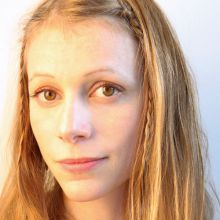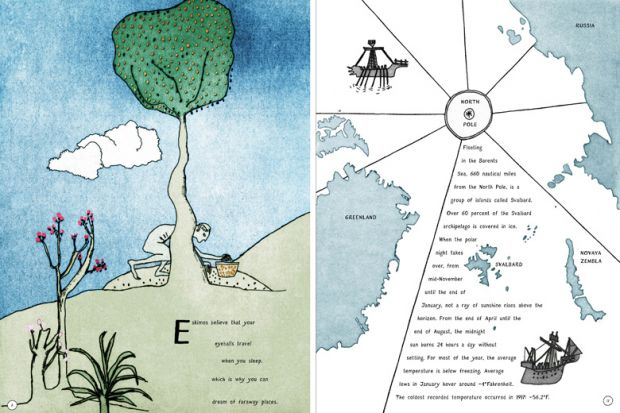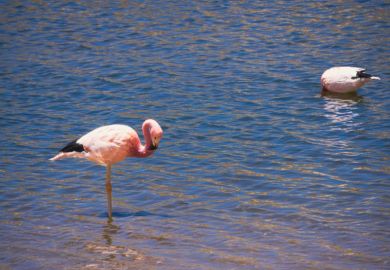How do you write tellingly about something as amorphous as the climate? Or, indeed, about a subject so politically freighted? Writer and artist Lauren Redniss has the answer. She illustrates it. In her extraordinary new book, Redniss presents a graphic non-fiction work (rather than a novel) that succeeds where other polemics fail: by drawing the reader into a world elementally defined, and exquisitely portrayed. Dividing her large-format volume into all-encompassing sections – Chaos, Cold, Rain, Dominion, Pleasure – Redniss deftly recasts the forecast by looking backwards as well as ahead. In doing so, she provides a synoptic view of the weather, and what it means to us.
The book begins startlingly, throwing us into the eye of the storm, with an arresting image. Using eyewitness accounts, Redniss relates a gothic side-effect of Hurricane Irene, which swept up from the Caribbean to New England in August 2011. As it hit Vermont, the tempest invaded Woodlawn Cemetery in Rochester, sweeping out the dead from their eternal rest. Like something out of a tale by Washington Irving, bones were borne out by the flood and into the fields. Sue Flewelling, the cemetery commissioner, and Elizabeth Bundock, the state medical examiner, faced the gruesome task of trying to reunite these remains with their identities, often resorting to DNA analysis or even asking relatives about distinguishing features of the deceased. “Most people expect their loved ones, once they’re buried, to remain that way,” Redniss comments. The living looked on as the dead were lost twice over.
Weather can be fatal, and fateful. In Canada’s Arctic, the Inuit believe that a sleeping person’s eyeballs move with them wherever they go in their dreams. For a white explorer, the day can prove more dangerous, inducing snow blindness. In the frozen North, it is not floods that threaten the dead, but predators on the ice. Hunters whose companions have died in winter have to share their huts with their deceased friends, for fear that bears or wolves prowling outside will dig up the corpses and feast upon them. In Svalbard, further east along the Arctic Circle, the other end of life is equally problematic. There is no gynaecologist at its hospital. As Redniss notes, “It would seem to make no sense to live in such a place – a place where it is too cold to be born, too cold to die.” Natural life slows down, limited by the restricted polar light. Under the penetrating gaze of a yellow-eyed Arctic owl, the curator of the Svalbard Museum tells us, “These light nights are strange. A peculiar sanctity rests over them. The waves seem to beat more gently, the birds fly more slowly. The night is like a dream of the day.”
Yet we humans insist on colonising places unfit for human habitation, determined to extend our dominion. Our generated light, powered by the energy we have inherited from our planet’s prehistory, turns night into day, cold into heat, and vice versa: we have never been meekly content with the Earth that we inherited. The burning heat of Las Vegas would be unliveable without the air conditioning that only contributes to the overheating climate. In Australia, bush fires ravage the landscape naturally, but while its plants and animals survive, we cannot. Redniss’ pictures in the section devoted to Fire burst alight with vivid oranges and reds; the pages themselves appear incandescent.
Equally, as we enter the murk of Fog, we are lost for several pages in grey nothingness out of which Redniss’ real-life characters speak as ghostly voices in the mist: “It don’t drop like a blind”, says Gerry Cantwell, “but it’s pretty close.” Meanwhile, the lighthouse he keeps on Cape Spear, Newfoundland flashes its signature code, the individual rhythms of light that state its location more firmly than any GPS. The fog, as we hear from Elizabeth Barrett Browning, swallows the human city, “as if a sponge has wiped out London”. Other freak weather has a different, literally electrifying effect. Laurie Procter-Williams, an American woman who struggled with addiction, was struck by lightning and claims that it turned her life around. “Touching the face of death enlivened me,” she says, almost as if nature had delivered its own dose of electroconvulsive therapy.
My favourite section in Redniss’ book deals with the exploits of Diana Nyad, the wonderfully named wild swimmer who, in September 2010, attempted to swim from Cuba to Florida. Along with the sharks, jellyfish, nausea and asthma attacks, she braved the vicissitudes of weather and prayed for the doldrums that would appall a sailor. As Redniss’ script runs over an inky scene of the depths below the Gulf of Mexico, where many-limbed octopuses lurk, Nyad drifts into the double-page spread as if we were swimming along with her. “In the doldrums, it’s like glass,” she says. “You’re just catapulting and streaming along the surface.”
This sense of movement reaches its apogee in the section named Sky, where the artist-author abandons words entirely for the uncaptionable beauty of clouds and sunsets. It is as though we were blown upwards ourselves. Her mix of story and fact, of image and poetry, is extraordinarily satisfying. It even leavens the book’s dark message – how the weather of our present augurs a worrying future. Redniss descends on a panel of experts discussing the viability, or even the desirability, of geo-engineering to hack our planet aright – using, for instance, sulphur dioxide pumped into the atmosphere to bounce the Sun’s rays back into space. Such acts seem to be the ultimate hubris. But as the environmental writer Emma Marris says, “We are already running the earth, whether we admit it or not.”
The beauty of Thunder and Lightning is to be found in its light and air, as well as its depth and shade. It celebrates its freedom from the tyrannies of the traditional text; let loose in a visual world, its words are allowed to float. Thus liberated, Redniss leads us with ease from Henry David Thoreau’s frozen Walden Pond, whose ice is exported to hotter climes (“the sweltering inhabitants of Charleston and New Orleans, of Madras and Bombay and Calcutta, drink at my well”), segueing within a page to contemporary issues of those who profit from climatic extremes, in what Naomi Klein calls “disaster capitalism”, and the entrepreneurs who exploit the devastation of modern “weather events” such as Hurricane Katrina.
This is a felt book. It has an innocence that melds with its knowingness. At times it reads like an adult version of a children’s encyclopedia; at others, like an update of William Blake’s visions. It lurches towards the apocalyptic – noting, for instance, that North America’s ever more tempestuous storms have been blamed on gays and lesbians – but it also delights with its depictions of the animals and birds that bear witness to our changing world, and theirs. In so doing, Redniss aims to capture the “sensation of strangeness, wonder, terror – that we experience in the presence of nature, most powerfully perhaps when encountering the forces of the elements: a howling wind, a thunderstorm, the beating sun”. These physical effects are embedded in her book. They linger in the reader’s mind, long after she or he has closed its pages.
Philip Hoare is professor of creative writing, University of Southampton, and author, most recently, of The Sea Inside (2013).
Thunder and Lightning: Weather Past, Present and Future
By Lauren Redniss
Jonathan Cape, 272pp, £20.00
ISBN 9780224096751
Published 4 February 2016
The author
 Lauren Redniss, assistant professor of illustration, art, media and technology at Parsons the New School, lives in New York City with her husband and two sons.
Lauren Redniss, assistant professor of illustration, art, media and technology at Parsons the New School, lives in New York City with her husband and two sons.
She grew up in New England, and recalls “spending a lot of time with my grandparents, working at my grandfather’s small grocery store in Worcester, Massachusetts. Business was often slow, so I had time to draw and make things while waiting for customers behind the cash.
“I was always making things – papier-mâché animals for a carousel or leather moccasins or something out of leaves. My dad taught us a lot about the natural world, like how to identify different plants and insects, or he’d have us count all the seeds in a sunflower to see if they added up to a Fibonacci number. My mom was a dancer. The idea of being an artist was so natural it almost didn’t need to have a name.”
Redniss took her first degree at Brown University. She was “extremely shy”, and “avoided much of what we (at least in the States) picture when we say ‘college life’. I had a job in ceramic storage at the local art museum, and I used to copy down the object descriptions and turn them into little poems. (Terrible poems no doubt. Thankfully, I think they are lost now.) Or I’d go draw in the greenhouse.”
Of her work at Parsons, she says “it is nearly impossible to generalise about the students I teach. It’s a pretty international group, with widely divergent backgrounds and interests. I have a student painting with phosphorescent ink she grew from bacteria in a lab, a student printing 3D puppets, another creating an animation of her grandmother accompanied by the soundtrack of their conversation about her increasing dementia, someone else building large masks…”
She describes Thunder and Lightning (and her acclaimed previous books Century Girl: 100 Years in the Life of Doris Eaton Travis, Last Living Star of the Ziegfeld Follies and Radioactive: Marie and Pierre Curie, A Tale of Love and Fallout) as “‘visual non-fiction’. I tell true stories with a fusion of words and images. The combination of words and images seems completely natural to me – we are accustomed to it on television or the internet or in film – so why not in a book?”
She continues: “I hope that all of the design choices – the layout, the typeface, the particular placement of words and even of each letter – affect the way a reader makes meaning of the information on the page. The spaces between letters and arrangement of lines of type are all elements that control pacing and emphasis. I want to use these effects mostly on a subconscious level, because I never want the reading experience of my work to be laborious.”
The typeface for Thunder and Lightning, Qaneq LR, was designed by Redniss herself, and she also designed a font for Radioactive.
“Because the type is integrated into the images, I want the lines of the letters to be crafted with as much care as any other line in the drawings. Also, I’m a control freak. I report and write the book, I make the artwork and design the layouts. I can’t imagine then just slapping it all together with Times New Roman or whatever. I made Qanek LR with a slight forward tilt, as if being blown by a gentle breeze.”
Has she a favourite of the far-flung locations she travelled to for Thunder and Lightning? “Many of the places I visited were extreme in one way or another, but Newfoundland is just extremely beautiful.”
If money were no object – let’s imagine a wildly lavish publisher and an unlimited budget – what kind of book would she like to make? “Life size, 5000 pages, black-lit, inflatable, anti-gravity.”
What gives her hope? Redniss replies: “My children. My husband and my friends. Also, invisible ink, going to the Metropolitan Museum, listening to pop music, and reading P. G. Wodehouse.”
Karen Shook
POSTSCRIPT:
Print headline: Exposed to the elements
Register to continue
Why register?
- Registration is free and only takes a moment
- Once registered, you can read 3 articles a month
- Sign up for our newsletter
Subscribe
Or subscribe for unlimited access to:
- Unlimited access to news, views, insights & reviews
- Digital editions
- Digital access to THE’s university and college rankings analysis
Already registered or a current subscriber?




